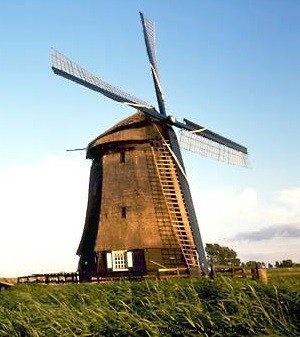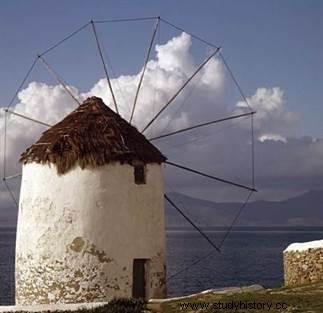 The wind was with water the first source of energy exploited by man. The first windmill first appeared in the East, in Ancient Egypt and in Persia where it was exploited for irrigation from the year 600 BC. The wings are arranged radially on a vertical axis. The idea of this type of mill will be transmitted by the Arabs to the West, where the device with a horizontal axis will be adopted. the use of the windmill became widespread in Europe from the 10th century in the most favorable areas, and it enjoyed a certain success, particularly with millers who used it to make flour.
The wind was with water the first source of energy exploited by man. The first windmill first appeared in the East, in Ancient Egypt and in Persia where it was exploited for irrigation from the year 600 BC. The wings are arranged radially on a vertical axis. The idea of this type of mill will be transmitted by the Arabs to the West, where the device with a horizontal axis will be adopted. the use of the windmill became widespread in Europe from the 10th century in the most favorable areas, and it enjoyed a certain success, particularly with millers who used it to make flour.
The first windmills
Seven hundred years before our era, the Persians cleverly take up the principle of sailing to build the first windmills. Subsequently, they are found in the West from the tenth century. They advantageously replace hand grinders for grinding cereals and plants (mainly for the production of oil) or for efficiently pumping water. The Iranian mills were made up of a vertical axis wind turbine confined inside the mill. This technique offered better yields than the horizontal axis wind turbines, widespread in Europe.
 Property of the great lords, the Windmills were at that time entrusted to the expertise of masters suckers .
Property of the great lords, the Windmills were at that time entrusted to the expertise of masters suckers .
The fan wing was one of the main improvements to the windmills. Invented in 1745, it was automatically placed downwind. In 1772 the spring wing was put into service, which consisted of wooden shutters whose opening was controlled manually or automatically. Its speed of rotation was thus made independent of that of the wind. Among the improvements, we can also mention the air brakes, intended to stop the rotation of the wings.
A development on the coast
Logically, windmills are mainly built along the coasts of the Atlantic Ocean and the Baltic Sea, where the winds are strong and steady . Gradually, they are then found in many Mediterranean countries. It's in Netherlands and Denmark that this ancestral technology is the most exploited. Thanks to the pumping carried out by the drainage mills, the Dutch managed to extend the area of their country by a quarter by advancing on the sea!
 Circa 1880,The Berton Wing , invented around 1840, is a system of mobile planks that can move apart to offer a wide grip in the wind. They exempt the miller from the heavy task of daily maneuvering the canvases. This system is spreading in the most productive regions of France (Beauce, Anjou, Brittany, etc.) but comes too late for a mill that is already in decline.
Circa 1880,The Berton Wing , invented around 1840, is a system of mobile planks that can move apart to offer a wide grip in the wind. They exempt the miller from the heavy task of daily maneuvering the canvases. This system is spreading in the most productive regions of France (Beauce, Anjou, Brittany, etc.) but comes too late for a mill that is already in decline.
Nowadays, France and Greece there are still many mills, often preserved by attachment to the heritage more than for their effective performance. For its part, the Netherlands still has a good thousand mills in operation, some of which near Kinderdijk are even listed as UNESCO World Heritage Sites . For centuries, the Dutch could only rely on wind energy. Today, due to pollution problems and the refusal to use nuclear energy, windmills are enjoying a resurgence in favor.
The wind turbine, a worthy successor to the windmill
The generalization of electricity in the countryside and the appearance of industrial milling led to a rapid decline in windmills during the 20th century. But the principle is now making a remarkable comeback, thanks to the appearance of the wind wheel with many blades, invented in the United States.
 Wind turbines began to be used to generate electricity in the late 19th century in Denmark, where they are still widespread. Small wind turbine generators provided electricity to small rural communities until the 1930s, when power lines began to crisscross the country. Large wind turbines were also built at this time.
Wind turbines began to be used to generate electricity in the late 19th century in Denmark, where they are still widespread. Small wind turbine generators provided electricity to small rural communities until the 1930s, when power lines began to crisscross the country. Large wind turbines were also built at this time.
Thanks to their long experience in harnessing the winds, the countries of northern Europe also have a strategic lead in the production of wind turbines, worthy successor to the ancient Moulin, whose development is spreading at high speed, driven by incentive policies with regard to so-called renewable energies .
To go further
- Au Temps des Moulins à Vent by Jean Guilbaud. 2005.
- The Fabulous History of Inventions - From Mastery of Fire to Immortality. Dunod, 2018.
